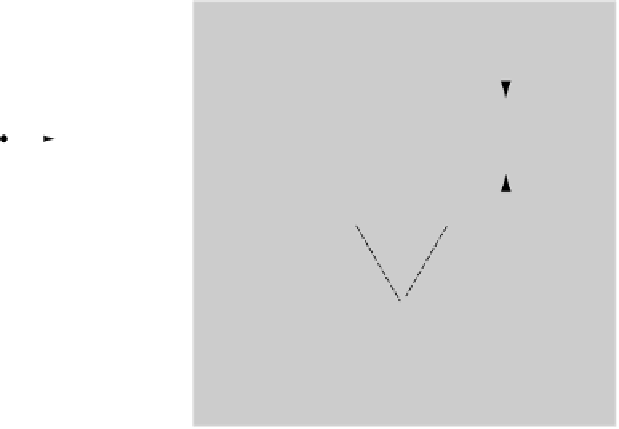Geoscience Reference
In-Depth Information
(a)
(b)
Fracture forms
at
s
n
,
t
t
s
1
s
1
a
a
u
u
s
3
s
1
s
3
s
3
s
n
s
3
s
3
s
n
s
1
30°
-30°
s
1
s
1
s
3
s
3
(c)
t
s
1
2
u
2
u
s
n
-2
u
-2
u
Fig. 4.87
Experiments at compression. (a) Mohr diagrams for increasing differential stress while maintaining constant the confining pressure.
A shear fracture will form at a critical stress level. (b) Geometrical representation of the shear fractures and their relation to the principal
compressive stresses in 2D. (c) The Coulomb fracture envelope.
n
so that
0. The rate of increasing shear strength with
increasing values of normal stress is represented by the
constant
MPa
m
= tan
f
t
f
. This constant is called the
Coulomb
coefficient
or
coefficient of internal friction
and
tan
the
angle
of internal friction
, which defines the slope angle of the
Coulomb envelope and the minimum stress value required
to overcome the rock frictional resistance and produce a
fracture. Considering the Mohr circles now, fractures will
be produced when the Mohr circle intercepts the two
envelopes and the coordinates of the tangent points will
give the values of the surface stress components at failure
and also the angles of the fractures with respect to the
principal compressive stress
t
c
f
2
u
= 90
°
+
f
2
u
= 120°
t
o
s
n
s
n
s
1
s
3
MPa
The Coulomb equation:
1
. Typical values for the angle
Fig. 4.88
The Coulomb envelope and criterion for fracture
formation in the compressive field.
of internal friction
for most rocks are 25
-35
; the angle
of internal friction is related to
by the equation,
2
(as is obvious in the Mohr diagrams;
Fig. 4.88). So, if an average of 30
90
is taken, the angle
will
at high values of shear stress and low values of normal
stress.
The two possible fractures that can be produced are
described as
conjugate shear planes
(Fig. 4.89). Such Coulomb
fractures will form at intermediate confining pressure values
and indicate a linear increase of the rock compressive
be 60
observed in
most experiments in the Coulomb field. Note that
fractures in these settings do not form at 45
which explains the fracture angle of 30
, which are
the planes of maximum shear stress, because the normal
stress also exerts an influence. The fractures tend to form


















































































Search WWH ::

Custom Search